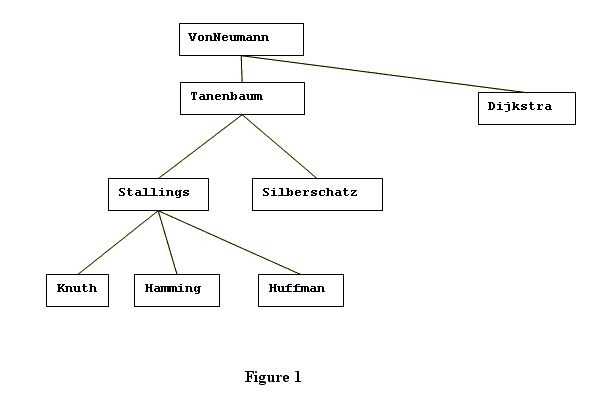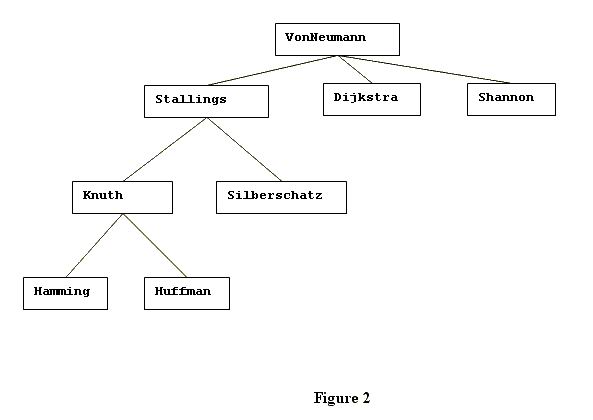Hire and Fire
| Time Limit: 1000MS | Memory Limit: 30000K | |
| Total Submissions: 2316 | Accepted: 655 |
Description
In this problem, you are asked to keep track of the hierarchical structure of an organization's changing staff. As the first event in the life of an organization, the Chief Executive Officer (CEO) is
named. Subsequently, any number of hires and fires can occur. Any member of the organization (including the CEO) can hire any number of direct subordinates, and any member of the organization (including the CEO) can be fired. The organization's hierarchical
structure can be represented by a tree. Consider the example shown by Figure 1:

VonNeumann is the CEO of this organization. VonNeumann has two direct subordinates: Tanenbaum and Dijkstra. Members of the organization who are direct subordinates of the same member are ranked by their respective seniority. In the diagram, the seniority of such members decrease from left to right. For example Tanenbaum has higher seniority than Dijkstra.
When a member hires a new direct subordinate, the newly hired subordinate has lower seniority than any other direct subordinates of the same member. For example, if VonNeumann (in Figure 1) hires Shannon, then VonNeumann's direct subordinates are Tanenbaum, Dijkstra, and Shannon in order of decreasing seniority.
When a member of the organization gets fired, there are two possible scenarios. If the victim (the person who gets fired) had no subordinates, then he/she will be simply dropped from the organization's hierarchy. If the victim had any subordinates, then his/her highest ranking (by seniority) direct subordinate will be promoted to fill the resulting vacancy. The promoted person will also inherit the victim's seniority. Now, if the promoted person also had some subordinates then his/her highest ranking direct subordinate will similarly be promoted, and the promotions will cascade down the hierarchy until a person having no subordinates has been promoted. In Figure 1, if Tanenbaum gets fired, then Stallings will be promoted to Tanenbaum's position and seniority, and Knuth will be promoted to Stallings' previous position and seniority.
Figure 2 shows the hierarchy resulting from Figure 1 after (1) VonNeumann hires Shannon and (2) Tanenbaum gets fired:


VonNeumann is the CEO of this organization. VonNeumann has two direct subordinates: Tanenbaum and Dijkstra. Members of the organization who are direct subordinates of the same member are ranked by their respective seniority. In the diagram, the seniority of such members decrease from left to right. For example Tanenbaum has higher seniority than Dijkstra.
When a member hires a new direct subordinate, the newly hired subordinate has lower seniority than any other direct subordinates of the same member. For example, if VonNeumann (in Figure 1) hires Shannon, then VonNeumann's direct subordinates are Tanenbaum, Dijkstra, and Shannon in order of decreasing seniority.
When a member of the organization gets fired, there are two possible scenarios. If the victim (the person who gets fired) had no subordinates, then he/she will be simply dropped from the organization's hierarchy. If the victim had any subordinates, then his/her highest ranking (by seniority) direct subordinate will be promoted to fill the resulting vacancy. The promoted person will also inherit the victim's seniority. Now, if the promoted person also had some subordinates then his/her highest ranking direct subordinate will similarly be promoted, and the promotions will cascade down the hierarchy until a person having no subordinates has been promoted. In Figure 1, if Tanenbaum gets fired, then Stallings will be promoted to Tanenbaum's position and seniority, and Knuth will be promoted to Stallings' previous position and seniority.
Figure 2 shows the hierarchy resulting from Figure 1 after (1) VonNeumann hires Shannon and (2) Tanenbaum gets fired:

Input
The first line of the input contains only the name of the person who is initially the CEO. All names in the input file consist of 2 to 20 characters, which may be upper or lower case letters, apostrophes,
and hyphens. (In particular, no blank spaces.) Each name contains at least one upper case and at least one lower case letter.
The first line will be followed by one or more additional lines. The format of each of these lines will be determined by one of the following three rules of syntax:
Here [existing member] is the name of any individual who is already a member of the organization, [new member] is the name of an individual who is not a member of the organization as yet. The three types of lines (hires, fire, and print) can appear in any order, any number of times.
You may assume that at any time there is at least one member (who is the CEO) and no more than 1000 members in the organization.
The first line will be followed by one or more additional lines. The format of each of these lines will be determined by one of the following three rules of syntax:
- [existing member] hires [new member]
- fire [existing member]
Here [existing member] is the name of any individual who is already a member of the organization, [new member] is the name of an individual who is not a member of the organization as yet. The three types of lines (hires, fire, and print) can appear in any order, any number of times.
You may assume that at any time there is at least one member (who is the CEO) and no more than 1000 members in the organization.
Output
For each print command, print the current hierarchy of the organization, assuming all hires and fires since the beginning of the input have been processed as explained above. Tree diagrams (such as
those in Figures 1 and 2) are translated into textual format according to the following rules:
The output resulting from each print command in the input will be terminated by one line consisting of exactly 60 hyphens. There will not be any blank lines in the output.
- Each line in the textual representation of the tree will contain exactly one name.
- The first line will contain the CEO's name, starting in column 1.
- The entire tree, or any sub-tree, having the form

will be represented in textual form as:

The output resulting from each print command in the input will be terminated by one line consisting of exactly 60 hyphens. There will not be any blank lines in the output.
Sample Input
VonNeumann
VonNeumann hires Tanenbaum
VonNeumann hires Dijkstra
Tanenbaum hires Stallings
Tanenbaum hires Silberschatz
Stallings hires Knuth
Stallings hires Hamming
Stallings hires Huffman
print
VonNeumann hires Shannon
fire Tanenbaum
print
fire Silberschatz
fire VonNeumann
print
Sample Output
VonNeumann
+Tanenbaum
++Stallings
+++Knuth
+++Hamming
+++Huffman
++Silberschatz
+Dijkstra
------------------------------------------------------------
VonNeumann
+Stallings
++Knuth
+++Hamming
+++Huffman
++Silberschatz
+Dijkstra
+Shannon
------------------------------------------------------------
Stallings
+Knuth
++Hamming
+++Huffman
+Dijkstra
+Shannon
------------------------------------------------------------
Source
Rocky Mountain 2004
题目链接:http://poj.org/problem?
题目大意:看题面和输入输出非常恐怖的样子。事实上题意非常简答。一棵树
A hires B 表示把B做为A的儿子
fire A 表示把A结点去掉。去掉以后其第一个儿子结点到它的位置,然后其第一个孙子结点到其第一个儿子结点出,以此类推。。
题目链接:http://poj.org/problem?
id=2003
题目大意:看题面和输入输出非常恐怖的样子。事实上题意非常简答。一棵树
A hires B 表示把B做为A的儿子
fire A 表示把A结点去掉。去掉以后其第一个儿子结点到它的位置,然后其第一个孙子结点到其第一个儿子结点出,以此类推。。
。直到叶子
print 表示按先序遍历,遍历整棵树,+号个数表示当前点所在层的层数
题目分析:想到好的数据结构能够简化一大部分问题,像这样的要对树上结点增删查的问题,我们採用多重链表来构树
多重链表结构体里有三个參数,点的名字,父指针,存储儿子指针的链表,还须要一个键值对存储作为子树根的结点相应的树指针。显然用map,详细操作看代码和凝视吧
#include <cstdio>
#include <string>
#include <iostream>
#include <list>
#include <map>
using namespace std;
struct Tree
{
string name; //结点名字
Tree *fa; //结点父指针
list <Tree *> son; //结点儿子指针链表
Tree()
{
fa == NULL;
}
};
map <string, Tree *> mp; //结点与其树指针的键值对
void Print(int dep, Tree *now) //先序递归输出
{
if(!now)
return;
for(int i = 0; i < dep; i++)
printf("+");
cout << now -> name << endl;
for(list <Tree *> :: iterator it = now -> son.begin(); it != now -> son.end(); it++)
Print(dep + 1, *it);
return;
}
void Fire(string del)
{
Tree *s = mp[del]; //得到该点的树指针
while((int)s -> son.size() != 0) //遍历最左位置
{
//以下三步相当于把当前结点的儿子上移
s -> name = s -> son.front() -> name;
mp[s -> name] = s;
s = s -> son.front();
}
//此时的s到达最左的叶子处,能够删除
mp.erase(del); //释放以del为根的子树
s -> fa -> son.remove(s); //将其从其父亲的儿子指针链表中删除
delete s; //删除s
}
void Hire(string fir, string sec)
{
Tree *f = mp[fir]; //得到父指针
Tree *s = new Tree(); //新建一个指针域
s -> fa = f; //将其指向父指针
s -> name = sec; //命名
mp[sec] = s; //建立其与树指针的键值关系
f -> son.push_back(s); //将其增加父亲的儿子指针链表中
return;
}
int main()
{
string rt, fir, sec;
cin >> rt;
Tree *root = new Tree();
mp[rt] = root;
root -> name = rt;
while(cin >> fir)
{
if(fir == "print")
{
Print(0, root);
printf("------------------------------------------------------------
");
}
else if(fir == "fire")
{
cin >> sec;
Fire(sec);
}
else
{
string tmp;
cin >> tmp >> sec;
Hire(fir, sec);
}
}
}